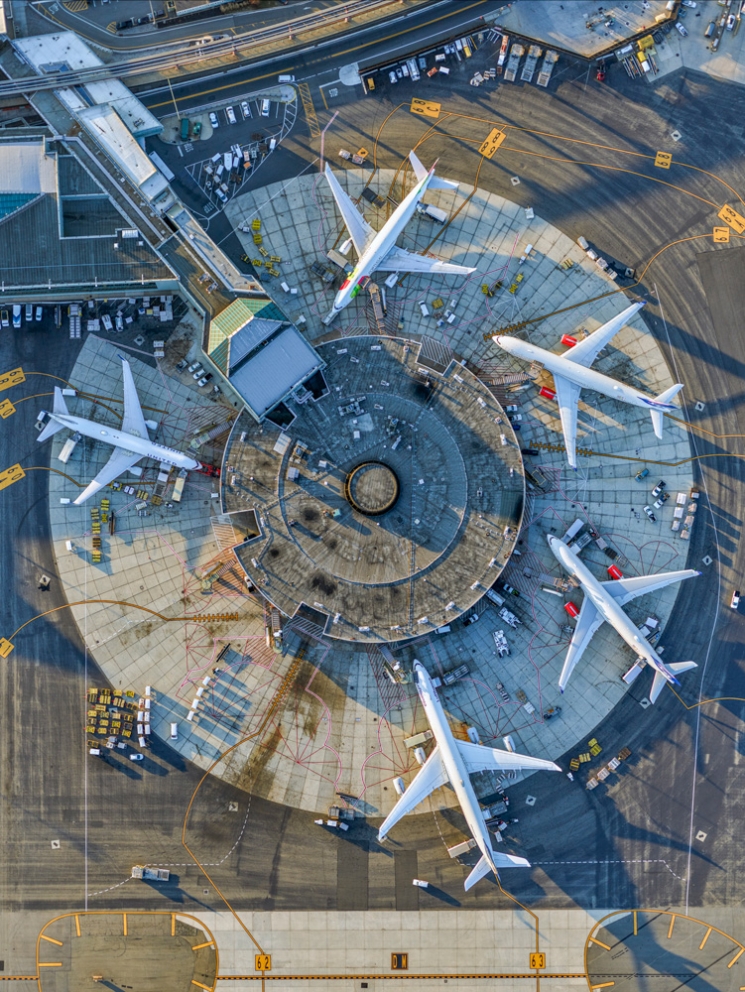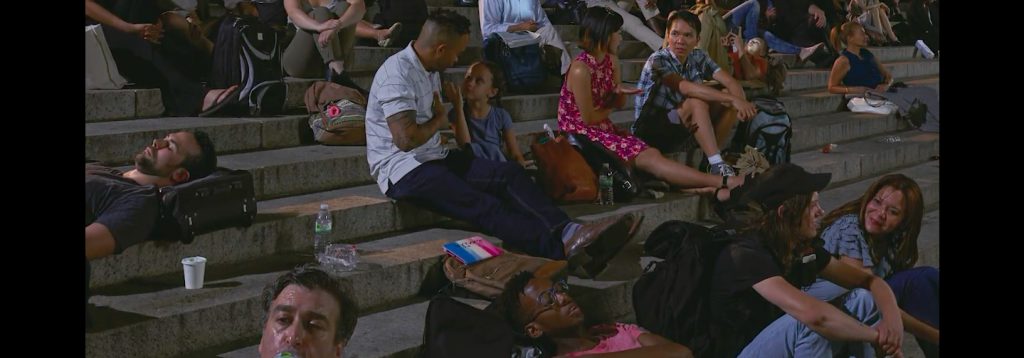Dawoud Bey is an American photographer and educator renowned for his large-scale color portraits. In this video, we explore some of his pictures which he took in a classroom with students. In my opinion, some of them represents “Utility” but most of them represent “Utopia”. The portraits that he took was in close-up and really close in to the frame. The subject in the photograph looks directly in to the camera whcih make seem like the subject is making an eye contact. Also, it makes the emotion that they are trying to show, more powerful for the viewer. Gestures and the light are also the important parts of the portraits. His point was giving the message with the content of the photograph.
Marcel Christ and Greg Shapps
Marcel Christ’s photographs are truly insane and nerve-racking. His photographs are shown in the apple backgrounds. He uses color-smoke and color-dust and photographs them in motion. They are truly beautiful. Most of his photographs has a dark background so the subject is literally the only thing in the picture. He catches the moment when it’s running away and it’s completely breathtaking. Greg Shapps’s picture are mostly taken in the healthcare business. In his picture, we see people interacting with healthcare workers. They look very secure and they feel like they’re being helped in this picture. Most of his photos has a cold look with a tint of blue that makes you feel cold. That helps to create the mood that you’re looking into a hospital bed. His photos are also very grainy. I’m not quite sure what he is trying to portray by that but I feel like his photos would have been better without the grains. They make it look old and fatal which doesn’t help with the mood of feeling safe and secure in the hospital environment.
Michael Paul Smith
Michael Paul Smith is a photographer who creates scenes and photos by using props and small objects. The subjects in his photographs are mostly vintage car’s toy model. His photographs are truly stunning. His style reminds me a lot of Carl Warner. His photographs looks very vintage. I’m not quite sure if he shoots film or digital but it looks very film-like. The colors, grain, light leaking all makes me believe that he shoots with film.
Carl Warner, Clare Barboza, Marcus Nilson
Carl Warner’s photographs are very surrealistic. Most of his photos are food-landscape. In the beginning when I started looking at his photos I assumed that the artist creates collage by mixing and blending various different photographs. But then I realized that he created the whole landscape in a studio with fruits and vegetables and then photographs the setting. It is truly stunning and the work that goes behind creating those photographs makes it much more appreciative for the audience.
Clare Barboza is also a food photographer. Her photograph has the vintage-ish, hipster type look. She uses colorful objects in her photographs but they have a dark feeling to it. Even though foods are colorful I think she desaturates the photos a little bit and uses small amount vignette on the corners.
Marcus Nilson’s photographs are out of the ordinary in some extent. It doesn’t look like he plays around with the food to find the perfect piece of fruit for the photos. He gives off the hnt of street photography in food photography. He shoots it as it is. His photos are raw and the breaks the rules of photography a lot. There’s chaos in his photos.
Philip-Lorca diCorcia
Philip-Lorca diCorcia is an American photographer who studied fine arts at School of the Museum of Fine Arts, Boston. HIs photographs are quite amusing. There’s a cooler color tone throughout most of his photographs. There’s a tint of blue present throughout most of his photographs. The lightings in his photographs are stunning. He knows what he wants to be lit and what the audience should look at and he uses light to have our eyes move around the photos and see them in order or how he wants us to see them. The subjects portrayed as a curious topic throughout his images wether it is portraying life as a mockery or society as a joke the photographs are very successful when it comes to raising question in the viewers’ mind.
Chelsea Galleries
On February 28 we went to different exhibits and three that I chose are from the Aperture, Benrubi Gallery, and David Zwirner.
Aperture Foundation: Exhibition: Prison Nation
Layla “Roach” Roberts (Inquisitor),
Photographer: Deborah Luster
I chose this photo because I think that there’s an interesting composition. The black background and the white clothing makes this photo more interesting. In this photo, I think that the man had a light 45 degrees because I can see on the right side of his face more light than the left side. Also, what makes this photo more interesting is the type of clothing that the man is wearing. He looks like some kinds of wealthy man. I feel that the kind of message that the photographer was trying to communicate is how people from those places live.
Benrubi Gallery: Exhibition: Leaning out
Photographer: Jeffrey Milstein
This photograph was one of my favorites. I love how the photographer shows us our daily life, but in a different view. I never thought how symmetrical an airport could be and how the afternoon light gives this photo a more authentic look. In our everyday life, we go to different places without thinking about our surrounding, but when you see the world in a different way even simple things like a plane, train, etc, can look amazing in photos. The shadows are important in a photo but I wish that I could see this photo without the shadows on the above-left side of the photo because I feel it would look more interesting.
Gallery: David Zwirner
Exhibition: Scenes from the Blackout (Photographer: Stan Douglas)
This was the last exhibition that we saw together. The first time that I saw this photo I didn’t know exactly what was it about, but when I was seeing more photos in the gallery I notice how this is how people “would react” if we had a blackout. I chose this photo because I don’t see people fighting or doing any kind of bad thing. They are just talking (some of them) and just waiting for things to go back to normal. The only thing that I don’t know is where the light on the left side is coming from (on the stairs) because if this is a blackout I feel that there is a lot of light and less shadow.
Michael Paul Smith
Michael Paul Smith is a photographer who creates realistic photos by capturing the detailed scenery with his camera. He is really good at taking these pictures outdoor and using his car collection and forced perspective. He mentioned that his process and his strong attention to the subjects are the keys to create these scenes. He eyeballs the scene to get a perfect frame with a forced perspective.
So as he said “Keep everything in scale. From the thickness of the shingles down to the wallpaper design and door knobs, everything must be in the proper relationship to each other”, he mentioned that the devil is in detail. In my opinion, we should take some time to get everything in a proper way and to make sure everything is set okay in the frame. I will try what he done for his work so far, and apply on to my shootings. I will definitely focus on the scale rule because I believe thats the main part of this project.
Micheal Paul Smith
Micheal Paul Smith is an interesting photographer. He amazes everyone with his style of photography. I love how toy cars and detail structure surround looks so real. Level of perception his photos have is so surreal because it looks like a real location where cars would be standing. He makes everything by hand which creates placement and scale. He knows how to angle every shot according to the location. He adds extra materials on roads to create a real experience. Looking at his photos can inspire me today use any objects nears and create a location to shoot. He is an expert in that but He changes our vision to create photos like his. He is changing the perspective of this of photography. His idea of using toy cars and detail models is very innovative and it evaluates on our vision to shoot in a different way.
Michael Paul Smith
Michael Paul Smith builds detailed miniature scenes and photographs them. Most of these tiny environments are of streets or involve cars. Smith pays attention to the details in the scene in relation to the surrounding background that will be included in the photo. By manipulating light, Smith creates the desired feel. The images are not filled with light, rather they have areas where light is focused and encourages the viewer to look at the whole photograph, or just a specific spot. The color scheme of the props in each scene are harmonious to one another, the background, and the subjects. For each image to look correct & appealing, Smith uses low angles and forced perspective to create interesting depth and angles throughout the scene.
By emulating the techniques Smith uses to create his work this week’s class shoot can be successful. This week I will be using different pattern cloths and gel lighting to covey the messages of the selected poems.
Richard Avedon & Jonathan Mannion
Richard Avedon is a legend. The New York Times said that “his fashion and portrait photographs helped define America’s image of style, beauty and culture for the last half-century”. All of his photography is black and white and is compose against a white background. He has captured lots of celebrities which includes Andy Worhol, Marylyn monroe, isek Dineson etc. Avedon was always intrigued by peoples expression and reaction. That is exactly what all his shot consist of. With minimalistic approach he captured the subject reaction up close.
Johnathan Mannion on the other hand is both a photographer and film director. He made a lot of cd covers and most of his shots like Avedon are black and white. Being that he was Avedon’s student a lot of his styles was an influenced to his. Eventhough most of his work is colorless he is very good at positioning his subject to describing of what they are about and who they as an artist, actor or singer. He has a talent of pacement and capturing emotions.






